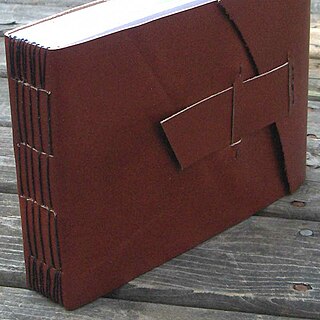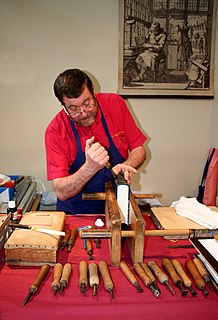
Quilting is the process of sewing two or more layers of fabric together to make a thicker padded material, usually to create a quilt or quilted garment. Typically, quilting is done with three layers: the top fabric or quilt top, batting or insulating material and backing material, but many different styles are adopted.

Appliqué is ornamental needlework in which pieces of fabric in different shapes and patterns are sewn or stuck onto a larger piece to form a picture or pattern. It is commonly used as decoration, especially on garments. The technique is accomplished either by hand or machine. Appliqué is commonly practised with textiles, but the term may be applied to similar techniques used on different materials. In the context of ceramics, for example, an appliqué is a separate piece of clay added to the primary work, generally for the purpose of decoration.

The St Cuthbert Gospel, also known as the Stonyhurst Gospel or the St Cuthbert Gospel of St John, is an early 8th-century pocket gospel book, written in Latin. Its finely decorated leather binding is the earliest known Western bookbinding to survive, and both the 94 vellum folios and the binding are in outstanding condition for a book of this age. With a page size of only 138 by 92 millimetres, the St Cuthbert Gospel is one of the smallest surviving Anglo-Saxon manuscripts. The essentially undecorated text is the Gospel of John in Latin, written in a script that has been regarded as a model of elegant simplicity.

A hardcover or hardback book is one bound with rigid protective covers. It has a flexible, sewn spine which allows the book to lie flat on a surface when opened. Following the ISBN sequence numbers, books of this type may be identified by the abbreviation Hbk.
Library binding can be divided into the two major categories of "original" and "after market". The original category is as it says, it was originally bound with the idea that the book would be used in a library setting where the book would receive harder use than those usual trade editions sold to the public.

Nålebinding is a fabric creation technique predating both knitting and crochet. Also known in English as "knotless netting," "knotless knitting," or "single needle knitting," the technique is distinct from crochet in that it involves passing the full length of the working thread through each loop, unlike crochet where the work is formed only of loops, never involving the free end. It also differs from knitting in that lengths must be pieced together during the process of nålebinding, rather than a continuous strand of yarn that can easily be pulled out. Archaeological specimens of fabric made by nålebinding can be difficult to distinguish from knitted fabric.

Backstitch or back stitch and its variants stem stitch, outline stitch and split stitch are a class of embroidery and sewing stitches in which individual stitches are made backward to the general direction of sewing. In embroidery, these stitches form lines and are most often used to outline shapes and to add fine detail to an embroidered picture. It is used as a hand-sewing utility stitch to attach definitively and strongly two pieces of fabric together. It is also used for writing.

A selvage or selvedge is a "self-finished" edge of fabric, keeping it from unraveling and fraying. The term "self-finished" means that the edge does not require additional finishing work, such as hem or bias tape, to prevent fraying.

Bindery refers to a studio, workshop or factory where sheets of (usually) paper are fastened together to make books, but also where gold and other decorative elements are added to the exterior of books, where boxes or slipcases for books are made and where the restoration of books is carried out.

In sewing and embroidery, a satin stitch or damask stitch is a series of flat stitches that are used to completely cover a section of the background fabric. Narrow rows of satin stitch can be executed on a standard sewing machine using a zigzag stitch or a special satin stitch foot.

Coptic binding or Coptic sewing comprises methods of bookbinding employed by early Christians in Egypt, the Copts, and used from as early as the 2nd century AD to the 11th century. The term is also used to describe modern bindings sewn in the same style.

Longstitch is a bookbinding technique used for sewing together the sections of a book. There are different forms of longstitch sewings. Longstitch binding does not require glue, though there are methods that utilize glue. In his book Non Adhesive Bindings, Keith Smith describes the "Longstitch through a slotted cover" and it involves sewing each section directly through the cover where slots have been made at each sewing station. This sewing method creates a staggered line pattern visible on the spine. Keith Smith indicates that this type of longstitch was used as early as the 18th century in some parts of Europe, and possibly earlier.
In bookbinding, swell refers to the increased thickness of a textblock along its spine edge after sewing. Swell is a function of the number of sections in the book, the kind of paper used, the style of sewing, and the thickness of the sewing thread. Human factors also influence swell, especially the force with which the bookbinder "bones down", or flattens, each section after sewing.

Soutache, also known as Russia braid, is a narrow flat decorative braid, a type of galloon, used in the trimming of drapery or clothing. Soutache is created by weaving a decorative thread around and between two parallel cords and completely covering the cores; this produces a piece of trim with a braided or herringbone pattern. Often woven of metallic bullion thread, silk, or a blend of silk and wool, soutache began to be made of rayon and other synthetic fibers in the 20th century.

A heddle is an integral part of a loom. Each thread in the warp passes through a heddle, which is used to separate the warp threads for the passage of the weft. The typical heddle is made of cord or wire, and is suspended on a shaft of a loom. Each heddle has an eye in the center where the warp is threaded through. As there is one heddle for each thread of the warp, there can be near a thousand heddles used for fine or wide warps. A handwoven tea-towel will generally have between 300 and 400 warp threads, and thus use that many heddles.
Oversewn bindings are a type of bookbinding produced by sewing together loose leaves of paper to form a text block. Threads pass through small holes that have been punched in the signature's gutter margin, forming overlock stitches that attach it to previously attached sections. This method of stitching is sometimes called stab sewing. A piece of linen is then glued to the text block spine for further support. The book's spine may be rounded and backed to keep it from caving in, but if the text block is too thick, the spine is sometimes left flat. A strip of cloth called a super is then often affixed to the spine of the text block and then to the boards of the case. Oversewing can be done by hand but is usually done with a machine in a bindery.
Limp binding is a bookbinding method in which the book has flexible cloth, leather, vellum, or (rarely) paper sides. When the sides of the book are made of vellum, the bookbinding method is also known as limp vellum.
Sewing is the craft of fastening or attaching objects using stitches made with needle and thread. Sewing is one of the oldest of the textile arts, arising the in Paleolithic Era. Although usually associated with clothing and household linens, sewing is used in a variety of crafts and industries, including shoemaking, upholstery, sailmaking, bookbinding and the manufacturing of some kinds of sporting goods. Sewing is the fundamental process underlying a variety of textile arts and crafts, including embroidery, tapestry, quilting, appliqué and patchwork.

Book rebinding is the renewal or replacement of the cover of a book. Typically, this requires restitching or renewal of the glue which holds the pages in place.














